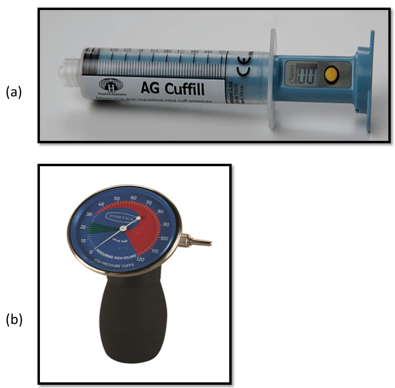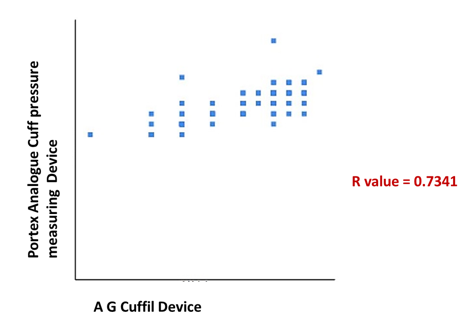- Visibility 370 Views
- Downloads 59 Downloads
- Permissions
- DOI 10.18231/j.ijpca.2022.017
-
CrossMark
- Citation
To study the efficacy of AG CUFFILL (Digital) compared to that of standard PORTEX cuff inflator/pressure analog gauge for the measurement of endotracheal tube cuff pressure
- Author Details:
-
Veena Vijayakumar
-
Bhavika Singla
-
Akshaya N. Shetti *
Abstract
Introduction: Endotracheal tube (ETT) is commonly used to provide positive pressure ventilation. ETT cuff pressure is maintained within a range of 20 to 30 cmH2O. High pressure affects micro-circulation and integrity of the tracheal mucosa, resulting in complications. The cuff pressure is measured by connecting a pressure gauge device to pilot balloon. Two variety devices are available; analog or digital manometers. Present study is used to study the efficacy of AG CUFFILLL (Digital) compared with standard PORTEX Cuff inflator/pressure gauge (Analog) for the measurement of ETT cuff pressure.
Materials and Methods: This study was conducted after obtaining institutional ethical clearance and written informed consent. 100 patients between the age of 18-70yrs who fulfilled inclusion criteria. We measured ETT cuff pressure using AG CUFFILL (Digital) and standard PORTEX Cuff inflator/pressure gauge and compared the pressure recording of the two equipment and we studied ease of use for both.
Result: Out of 100 patients between the age of 18-70yrs, 61 patients (61%) were male and 39 patients (39%) were female. Mean cuff pressure of ETT using AG CUFFILL was 36.29±6.36 cmH2O and in PORTEX was 33.97±6.16cm H2O. Mean difference in the values between the cuff pressure measured by AG CUFFILL and PORTEX was ± 2.67. Comparing the two devices, it was noticed that in 05 (5%) patients measuring ETT cuff pressure using AG CUFFILL was difficult as the values were fluctuating.
Conclusions: Based on results, authors recommend AG CUFFILL for ETT cuff pressure measurement owing to its accuracy, non-bulky, and ease to carry.
Introduction
Intubation with endotracheal tube (ETT) has been regarded as a benchmark of maintaining the airway. The cuff at the end of the tracheal tube plays a vital role by preventing leakage of gases, prevention of aspiration, and holding the tube in situ. The cuff pressure to prevent air leakage and aspiration has been found to be 20-30 cm of water. Various complications like tracheal pain, vocal cord paralysis, tracheo-oesophageal fistula formation, tracheal stenosis, and tracheal perforation are observed if cuff pressure is not maintained. Obstruction to mucosal blood flow occurs at a pressure above 30cmH2O. In patients after anesthesia sore throat is usually due to ischaemia in oropharyngeal and tracheal mucosa.[1], [2], [3], [4] Mucosal injuries by excessive cuff pressure typically occur 1-3 hours after intubation, but in patients with low cardiac output and unstable hemodynamic mucosal injury happens even in low cuff pressure.[5], [6], [7], [8] Maintaining normal cuff pressure is challenging due to possible leakage post inflation.[9], [10], [11], [12]
Various techniques are practiced to maintain adequate ETT cuff pressure. The first one is measuring ETT cuff pressure by connecting a pressure gauge device to the pilot balloon of the ETT. Some devices, such as the Analog or digital manometer, are in practical usage.[13], [14] The second technique is the manual method, which is the most commonly practiced. This technique, indirectly, measures the ETT cuff pressure by palpating the ETT pilot balloon and based on one’s experience. Although it is commonly used, this technique will not provide full proof of patient safety.[15], [16] Since measuring devices like Analog manometers is bulky, the manual palpation technique is most commonly practiced. AG CUFFILL device is a newer product in the market which is used for measuring cuff pressure and is easy to carry, and a digital display is present. In this study, we aimed to see the efficacy and ease of AG CUFFILL with that of standard technique PORTEX cuff inflator.
Materials and Methods
After obtaining institutional ethical clearance and informed written consent from the relatives, this study was conducted. A total of 100 each, ETT pressure cuff readings were taken independently for AG CUFFILL device and standard Portex Analog manometer ([Figure 1] a and 1b). The patients aged more than 16 years who were intubated and on ventilator were included in this study. To maintain uniformity, we did exclude the patient who are having cuffed tracheostomy tubes. The measurement of ETT cuff pressure for the same patient was allowed if the last recorded reading was more than 24 hours. The critical care nurse who is not involved in this study took all the readings. The readings from each are recorded. If the pressure measurement was done in a single attempt, then it is considered to be easy and if more number of attempts were used then it was considered as difficult. Thus, the ease of use of the device is also recorded.
Sample size
Since AG cufffill equipment allows only 100-time reading, we restricted to 100 readings.

Results
A total of 100 each, ETT pressure cuff readings were taken independently for AG CUFFILL device and standard Portex Analog manometer. Out of 100 patients, 61 patients (61%) were male and 39 patients (39%) were female. Mean cuff pressure of ETT using AG CUFFILL was 36.29±6.36 cm H2O and using PORTEX was 33.97±6.16 cm H2O. The mean difference in the values between the cuff pressure measured by AG CUFFILL and PORTEX was ± 2.67. The ease of measurement of ETT cuff pressure 100% using A G CUFFILL equipment, while with Portex analog manometer was 96%. Pearson correlation was calculated between the mean readings of both groups ([Figure 2]). The R value of Pearson correlation is 0.7341.

Discussion
There are various advantages of cuffed endotracheal tube viz, prevention of aspiration, adequate sealing which inturn helps for proper mechanical ventilation and keeping the ETT in situ. For all these purposes, it is critical to maintain adequate ETT cuff pressure. It is impossible to visualize the ETT cuff or direct intra cuff pressure measurement once insertion is done, thus making indirect pressure measurement the only option. Various techniques are practiced to measure the ETT cuff pressure. In this study, we aimed to compare two devices; the standard Portex analoge manometer with a digital AG CUFFILL device.
Here in our study, we compared the ease of utilization of the equipment. All 100 readings for each device were taken by a resident of anaesthesiology who was trained before the conduct of the study. A Pearson’s correlation was calculated for the mean cuff pressure in both the groups. The calculated R value is 0.7341 which shows a moderate positive correlation between the two device’s readings. There are no previous such studies to make a comparison of our study outcomes.
In this study, we included 100 patients and both devices were used on these patients. Our study results showed the AG CUFFILL device in comparison to portex manometer was very easy to use for all except in 5 patients where the operator did notice fluctuation in the readings after connecting the device to the pilot balloon of ETT. The fluctuation lasted for 5 to 10 seconds and the reading got stabilized after that. This could be possibly a minor technical error of the device. In all five patients, the reading was taken after showing a fixed value. There are advantages and disadvantages with AG CUFFILL device. The main advantages are, the instrument is not bulky, easy to store, easy to place in the patient locker or on the ventilator, it also helps in avoiding cross-infection as it is cost-effective thus making one device one patient concept. The main disadvantage is, it gives restricted times of reading which makes the user to buy a new device.
Limitation of The Study
The study sample size was 100 based on a maximum number of measurements that we could conduct using AG CUFFILL device. Secondly, all the measurements were done for the ETT and did not consider other devices which have cuff like, laryngeal mask airways. A further study can be considered.
Conclusion
Both Portex Analog cuff pressure monitoring device and AG CUFFILL syringe effectively measured the ETT cuff pressure in the pilot balloon. When both devices were compared, the AG CUFFILL syringe had the best performance for inflating ETT cuff to the defined safe pressure range as it gives a digital display with good accuracy. The AG CUFFILL is easy to use, accurate, and not bulky. It also has various advantages in terms of quick reading, non-bulky, easy to carry, numerical display, a single device can be prescribed for a single patient as it is cost-effective and avoids cross-infection. AG CUFFILL has a disadvantage of the limited number of readings per unit.
Source of Funding
None.
Conflict of Interest
None.
References
- Sanaie S, Rahmani F, Chokhachian S, Mahmoodpoor A, Panahi R. Comparison of tracheal tube cuff pressure with two technique: fixed volume and minimal leak test techniques. J Cardiovasc Thorac Res. 2019;11(1):48-52. [Google Scholar]
- Nseir S, Duguet A, Copin MC, Jonckheere D, Zhang J, Similowski M. Continuous control of endotracheal cuff pressure and tracheal wall damage: a randomized controlled animal study. Crit Care. 2007;11(5). [Google Scholar]
- Blanch PB. Laboratory evaluation of 4 brands of endotracheal tube cuff inflator. Respir Care. 2004;49(2):166-73. [Google Scholar]
- Bernhard WN, Yost L, Joynes D, Cothalis S, Turndorf H. Intracuff pressures in endotracheal and tracheostomy tubes. Related cuff physical characteristics. Chest. 1985;87(6):720-5. [Google Scholar]
- Sengupta P, Sessler DI, Maglinger P. Endotracheal tube cuff pressure in three hospitals, and the volume required to produce an appropriate cuff pressure. BMC Anaesthesiol. 2004;4(1):4-8. [Google Scholar]
- Dullenkopf A, Gerber A, Weiss M. Fluid leakage past tracheal tube cuffs: Evaluation of the new Micro cuff endotracheal tube. Intensive care Med. 2003;29(10):1849-53. [Google Scholar]
- Taslimi L, Mohammadi K, Ghanbari T, . Study of endotracheal tube cuff pressure and time of measurement among intensive care units patients. J Holist Nurs Midwifery. 2016;26(2):29-37. [Google Scholar]
- Galinski M, Tréoux V, Garrigue B. Intracuff pressures of endotracheal tubes in the management of airway emergencies: the need for pressure monitoring. Ann Emerg Med. 2006;47(6):545-52. [Google Scholar]
- Sole ML, Su X, Talbert S, Penoyer DA, Kalita S, Jimenez E. Evaluation of an intervention to maintain endotracheal tube cuff pressure within therapeutic range. Am J Crit Care. 2011;20(2):109-26. [Google Scholar]
- Raha AR, Haslinda S, Nadia MN, Nurlia Y. Estimation of endotracheal tube cuff pressure among Anaesthesia providers does experience matter?. J Surg Acad. 2011;1(2):53-9. [Google Scholar]
- Carhart E, Stuck LH, Salzman JG. Achieving a safe endotracheal tube cuff pressure in the prehospital setting: is it time to revise the standard cuff inflation practice?. Prehosp Emerg Care. 2016;20(2):273-80. [Google Scholar]
- Harvie DA, Darvall JN, Dodd M, Cruz DL, Tacey A, Costa D. The minimal leak test technique for endotracheal cuff maintenance. Anaesth Intensive Care. 2016;44(5):599-604. [Google Scholar]
- Das S, Kumar P. Comparison of minimal leak test and manual cuff pressure measurement technique method for inflating the endotracheal tube cuff. Indian J Clin Anaesth. 2015;2(3). [Google Scholar]
- Khan MU, Khokar R, Qureshi S, Zahrani A, Aqil T, Shiraz M. Measurement of endotracheal tube cuff pressure: Instrumental versus conventional method. Saudi J Anaesth. 2016;10(4):433-54. [Google Scholar]
- Rahmani F, Soleimanpour H, Zeynali A, Mahmoodpoor A, Nia S. Comparison of tracheal tube cuff pressure with two techniques: fixed volume versus pilot balloon palpation. J Cardiovasc Thorac Res. 2017;9(4):196-9. [Google Scholar]
- Fernandez R, Blanch L, Mancebo J, Bonsoms N, Artigas A. Endotracheal tube cuff pressure assessment: pitfalls of finger estimation and need for objective measurement. Crit Care Med. 1990;18(12):1423-9. [Google Scholar]
How to Cite This Article
Vancouver
Vijayakumar V, Singla B, Shetti AN. To study the efficacy of AG CUFFILL (Digital) compared to that of standard PORTEX cuff inflator/pressure analog gauge for the measurement of endotracheal tube cuff pressure [Internet]. Int J Pharm Chem Anal. 2022 [cited 2025 Oct 28];9(2):105-108. Available from: https://doi.org/10.18231/j.ijpca.2022.017
APA
Vijayakumar, V., Singla, B., Shetti, A. N. (2022). To study the efficacy of AG CUFFILL (Digital) compared to that of standard PORTEX cuff inflator/pressure analog gauge for the measurement of endotracheal tube cuff pressure. Int J Pharm Chem Anal, 9(2), 105-108. https://doi.org/10.18231/j.ijpca.2022.017
MLA
Vijayakumar, Veena, Singla, Bhavika, Shetti, Akshaya N.. "To study the efficacy of AG CUFFILL (Digital) compared to that of standard PORTEX cuff inflator/pressure analog gauge for the measurement of endotracheal tube cuff pressure." Int J Pharm Chem Anal, vol. 9, no. 2, 2022, pp. 105-108. https://doi.org/10.18231/j.ijpca.2022.017
Chicago
Vijayakumar, V., Singla, B., Shetti, A. N.. "To study the efficacy of AG CUFFILL (Digital) compared to that of standard PORTEX cuff inflator/pressure analog gauge for the measurement of endotracheal tube cuff pressure." Int J Pharm Chem Anal 9, no. 2 (2022): 105-108. https://doi.org/10.18231/j.ijpca.2022.017
